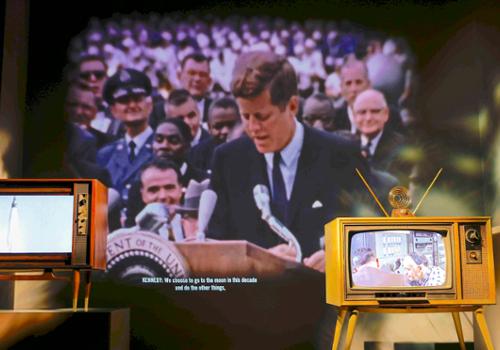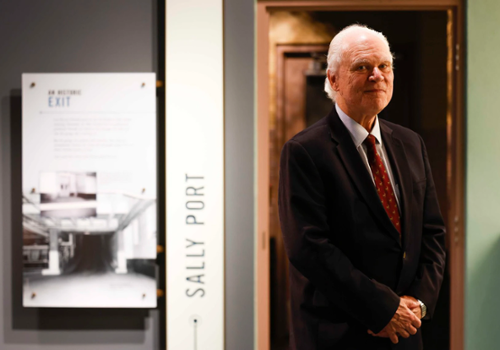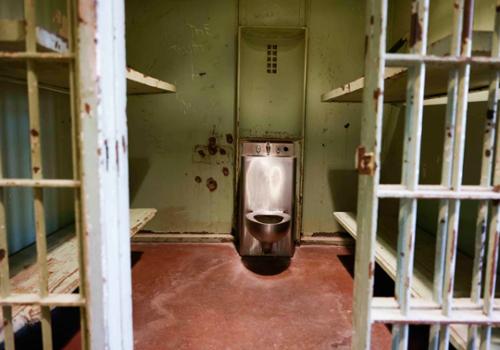UNTD and JFK: Site where Oswald was shot has new exhibit
July 18, 2022
Article originally published by The Dallas Morning News
 You can go one of two ways with history. You can wipe it away. Pretend it never happened.
Or you can embrace it, preserve it, try to understand it.
You can go one of two ways with history. You can wipe it away. Pretend it never happened.
Or you can embrace it, preserve it, try to understand it.
It’s a dilemma the city of Dallas has faced before.
When the Texas School Book Depository lay dormant for years, some of the city’s more prominent citizens — Cowboys Coach Tom Landry and cosmetics queen Mary Kay Ash among them — spoke out loud for the former.
Both called for the building’s demolition. One of its sixth-floor windows had, after all, served as a sniper’s nest for the man who fired the shots that killed President John F. Kennedy on Elm Street in 1963. In the end, the opposing side won out, and The Sixth Floor Museum at Dealey Plaza opened in 1989.
Not long ago, the UNT Dallas College of Law faced the same predicament. Established in 2014, the law school moved in 2019 to 106 S. Harwood St. — to the building known as Old City Hall — after a $71 million restoration.
Part of that restoration deals exclusively with the thorniest history of a building that opened the same year that World War I began. It is a moving permanent exhibition titled “November 22, 1963: The Aftermath,” a 2,500-square-foot, $2.5 million undertaking whose design was carefully thought out and executed by a blue-chip committee of local citizens and stamped with approval by the Texas Historical Commission.
It is not yet open to the public, but the school wants to change that this year. Among other chapters of the 72-hour nightmare, it documents the worst thing that ever happened in the building, which once housed a 24-year-old man accused of assassinating an American president but who never saw his day in court because he was murdered in the basement.
Before the project could be completed — or even begun — questions had to be answered.
The lingering drama forced UNT Dallas to confront the question that has shadowed the city for almost 60 years:
How do we handle the assassination?
How do we deal with the fact that what used to be known as City Hall served as the location in 1963 for both the city’s police department and the spartan cell where suspected assassin Lee Harvey Oswald was incarcerated from Nov. 22 to Nov. 24?
Oswald’s grim fate became part of the tangled history that has hovered over the building. Two days after President Kennedy was assassinated, Oswald was gunned down in the basement by strip club operator Jack Ruby.
Pulitzer Prize-winning author Lawrence Wright, who was sitting in a class at Woodrow Wilson High School on the day Kennedy was assassinated, has long maintained that Ruby killing Oswald scarred Dallas’ image more than the assassination itself.
“I don’t think that Dallas killed Kennedy,” Wright once said, “but it was responsible for killing Oswald.”
Which brings us to Robert Mong, former editor of The Dallas Morning News. Mong has served as president of the University of North Texas at Dallas and its College of Law since 2015. Mong is among those who felt the history of the building had to be preserved.

The JFK exhibit was completed in late December. The College of Law has its eye on a partner that would manage the space, which Mong envisions primarily as a weekend destination. So far, he says, “a few hundred” people have seen it.
Its admirers include Nicola Longford, chief executive officer of The Sixth Floor Museum at Dealey Plaza.
“There are few better ways to experience the power of place than by stepping into an original period structure or walking across a preserved historic site where the past intersects the present,” Longford says.
Chad Joyce, senior construction project manager for the College of Law, says the renovation of the building lasted from June 2017 to July 2019. It took six months to complete the exhibit but even longer to assess the space and to document its history.
But what makes the finished product so compelling, Mong says, is the work of Split Rock Studios, a Minnesota-based design firm whose creation forces a visitor to confront a dark chapter of 1963 and walk away with fresh insight.
“Outstanding,” Mong says of Split Rock. “They were so attentive. They did some outsourcing, but they did the bulk of the thinking, the research. I think what it crystallized in my mind is how that weekend made us, as a nation, rethink a lot of things we’d either taken for granted or not thought deeply about. Like presidential security. Prisoner rights. On and on and on. The themes are endless.”
It has been well documented that Kennedy drove past 20,000 open windows as his presidential motorcade passed through the streets of downtown Dallas on Nov. 22, 1963. Secret Service advance man Winston G. Lawson told The Dallas Morning News in 2003 that he had warned the president that he was unable to place agents in any one of those windows — much less 20,000.
Security or the lack thereof also figured heavily in the events of Nov. 24, 1963, when Ruby entered the basement of the police station without being vetted. He’s believed to have walked past a single individual guarding the entrance on the Main Street side, moments before Oswald was scheduled to be transferred from the city jail to the county jail. Minutes later, Ruby killed Oswald with a single, fatal shot from his .38-caliber Colt Cobra.
Even before he died, the handling of Oswald left much to be desired.
In a misguided attempt at transparency, Dallas police trotted out Oswald for a bizarre hallway press conference soon after his arrest. Standing against the wall, just a few feet away, was the man who would kill him two days later — Ruby — having entered the building unfettered, as he would once again less than 48 hours later.
/cloudfront-us-east-1.images.arcpublishing.com/dmn/M6RD7LUSFFCNPPYRQVEVCTYMOA.JPG)
In this Nov. 23, 1963 file photo, surrounded by detectives, Lee Harvey Oswald talks to the press as he is led down a corridor of the Dallas police station for another round of questioning in connection with the assassination of U.S. President John F. Kennedy. Oswald, who denied any involvement in the shooting, was killed two days later, live on television, in the basement of the Dallas Police Headquarters, by local nightclub owner Jack Ruby. (associated press / AP)
The exhibit shows footage of Kennedy clamoring for Americans to win the space race against the Soviet Union, to be the first in the world to place men on the moon. Such challenges are worth doing, the young president implored, “not because they are easy but because they are hard.”
And yet, amid the splendor of Camelot, as the Kennedy era was called, “A storm was gathering.”
Taylor, a Dallas native who co-starred with Sam Waterston in the Emmy Award-winning NBC series, I’ll Fly Away, speaks of “African Americans marching for civil rights” and the Cuban Missile Crisis of 1962 pushing America and the Soviet Union to the brink of nuclear war. And yes, war in Vietnam was also a potential threat, despite being a place “most Americans had never heard of.”
“The winds of change were blowing in,” Taylor says, with Bob Dylan punctuating the mood by singing “Blowin’ in the Wind.”
What follows is the gut wrench: CBS legend Walter Cronkite informs the nation about the firing of three shots at Dealey Plaza in Dallas — and then, at 1 p.m. “Central Standard Time,” one of the biggest shocks of the 20th century: President Kennedy is pronounced dead at Parkland Hospital.
The museum brims with interactive touch panels, floor maps, time stamps and even 1960s-era black and white television sets, which curators worked hard to secure. One of the clever features is pull-out drawers, each of which contains layers of information in limited space.
At times, the exhibit has the feel of a cake, with each new slice offering gradients of knowledge leading to the next compelling moment.
The exhibit follows a linear timeline of Oswald’s movements after Kennedy was shot. You see the harsh simplicity of the police booking room. You hear details about the lineup, in which Oswald stands rigidly as one of several looming suspects. With Taylor’s narration heightening the moment, serious questions are raised about a lineup that felt, at the very least, strangely flawed.
Oswald had a cut over his eye, a casualty of his arrest at the Texas Theatre in Oak Cliff. No other person in the lineup had such a cut. Oswald was wearing a T-shirt (no one else was). And some of the citizens asked to identity the probable killer of an American president had already seen Oswald on TV newscasts.
Video plays an engaging role throughout the exhibit, especially when a journalist asks Oswald if he killed the president. His eyes darting, he says: “No, I have not been charged with that. Nobody has said that to me yet.” Odd response, given that he shows not a shred of defiance in the face of such a monstrous allegation.
 As one might expect, the exhibit in the College of Law also covers how Dallas police
handled Oswald’s legal counsel. In the end, they contacted H. Louis Nichols, who was president of the Dallas Bar Association. Nichols came to the jailhouse to
see Oswald.
As one might expect, the exhibit in the College of Law also covers how Dallas police
handled Oswald’s legal counsel. In the end, they contacted H. Louis Nichols, who was president of the Dallas Bar Association. Nichols came to the jailhouse to
see Oswald.
“He did not appear to be defiant,” Nichols says, calling the man suspected of killing the nation’s 35th president and Dallas police officer J.D. Tippit “rational” and “calm.”
One of the more trenchant elements is what you see on the fifth floor — where Oswald was incarcerated. You’re able to enter his former cell and stand inches from where he slept, peering at a grim, gray cell, fitted with narrow metal bunk beds and a toilet.
Taking the elevator from the fifth floor to the basement, you can peer through a window and see where Oswald was shot. You feel the emotion of his final steps — from his cell to the elevator, from which he entered the basement before Ruby emerged from the shadows.
For the same reason that millions of people have gone to Auschwitz and Pearl Harbor, Babi Yar and Wounded Knee, people continue coming to Dallas to see where President Kennedy was killed.
And now, there is one more place to visit.
Mong understands their motivations. Rather than UNT Dallas turning its back on the mounds of history nestled in its building, the College of Law has chosen to embrace it. Not repress it.
“Because we’re a working law school, we hope to find a partner to open it on weekends, for tours and special events. The space offers so many opportunities for thematic programming” — not the least of which is a carefully designed, artfully rendered exhibit, about the darkest chapter in Dallas history.